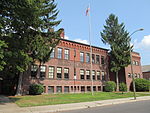WACE (AM)
WACE (730 kHz) is an AM radio station broadcasting a Catholic radio format. Licensed to Chicopee, Massachusetts, the station serves the Springfield radio market and has been permitted to identify itself as "Chicopee-Springfield" since 1969. The station is owned by Holy Family Communications, and operates as part of its The Station of the Cross network. EWTN Radio programming is also heard. By day, WACE transmits 5,000 watts, using a non-directional antenna. 730 AM is a clear channel frequency reserved for Canada and Mexico. To avoid interference with other stations, WACE must reduce power at night to 7 watts. The transmitter is off West Street in Springfield, near the North End Bridge and the Connecticut River.
Excerpt from the Wikipedia article WACE (AM) (License: CC BY-SA 3.0, Authors).WACE (AM)
West Street, Springfield
Geographical coordinates (GPS) Address Nearby Places Show on map
Geographical coordinates (GPS)
| Latitude | Longitude |
|---|---|
| N 42.109261111111 ° | E -72.610644444444 ° |
Address
West Street
01107 Springfield
Massachusetts, United States
Open on Google Maps







